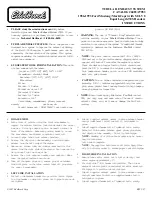
Airbags inflate in moderate to high speed impacts. Along
with seat belts and pretensioners, front airbags work with
the driver inflatable knee blocker and the integrated
passenger knee blocker (non-inflatable) to provide im-
proved protection for the driver and front passenger. Side
airbags also work with seat belts to improve occupant
protection.
The seat belts are designed to protect you in many types
of collisions. The front airbags deploy in moderate to
severe frontal collisions. If your vehicle is equipped, the
side airbag on the crash side of the vehicle is triggered in
moderate to severe side collisions. In certain types of
collisions, both the front and side airbags may be trig-
gered. But even in collisions where the airbags work, you
need the seat belts to keep you in the right position for
the airbags to protect you properly.
NOTE:
The passenger front airbag may not deploy
even when the driver front airbag has if the Occupant
Classification System (refer to
⬙
Occupant Classification
System
⬙
in this section) has determined the passenger
seat is empty or is occupied by someone that is classified
in the “child
⬙
category. This could be a child, a teenager,
or even a small adult.
Here are some simple steps you can take to minimize the
risk of harm from a deploying airbag.
1.
Children 12 years old and under should always ride
buckled up in a rear seat.
Infants in rear facing child restraints should
NEVER
ride
in the front seat of a vehicle with a passenger front airbag.
An airbag deployment can cause severe injury or death to
infants in that position.
Children that are not big enough to properly wear the
vehicle seat belt (see Section on Child Restraints) should
be secured in the rear seat in child restraints or belt-
positioning booster seats. Older children who do not use
child restraints or belt-positioning booster seats should
ride properly buckled up in the rear seat. Never allow
children to slide the shoulder belt behind them or under
their arm.
THINGS TO KNOW BEFORE STARTING YOUR VEHICLE
41
2
Summary of Contents for 2007 Caliber
Page 2: ......
Page 5: ...INTRODUCTION 5 1...
Page 64: ......
Page 89: ...UNDERSTANDING THE FEATURES OF YOUR VEHICLE 89 3...
Page 90: ...90 UNDERSTANDING THE FEATURES OF YOUR VEHICLE...
Page 91: ...UNDERSTANDING THE FEATURES OF YOUR VEHICLE 91 3...
Page 129: ...Removing Flashlight Three Press Switch UNDERSTANDING THE FEATURES OF YOUR VEHICLE 129 3...
Page 141: ...INSTRUMENT PANEL FEATURES UNDERSTANDING YOUR INSTRUMENT PANEL 141 4...
Page 142: ...INSTRUMENT CLUSTER BASE 142 UNDERSTANDING YOUR INSTRUMENT PANEL...
Page 143: ...INSTRUMENT CLUSTER PREMIUM UNDERSTANDING YOUR INSTRUMENT PANEL 143 4...
Page 203: ...Operating Tips UNDERSTANDING YOUR INSTRUMENT PANEL 203 4...
Page 232: ...232 STARTING AND OPERATING...
Page 279: ...ENGINE COMPARTMENT GASOLINE ENGINES MAINTAINING YOUR VEHICLE 279 7...
Page 345: ...INDEX 10...
Page 360: ...NOTES...
















































